- Products
- Solutions
- Service
- Company
Lean production has been a widespread approach to efficient manufacturing processes since the 1990s. The so-called flow principle is closely associated with this. The aim of this is to achieve a fast and uninterrupted flow of materials and information in order to minimize lead times along the entire value chain.
Hager Electro, based in Blieskastel in the Saarland, also follows this philosophy. The globally active company is a leading supplier in the field of power supply for houses. Its main products are meter cabinets and small distribution boards. Meter cabinets basically consist of the housing and the actual technology, which is housed in a so-called complete field. Later in the house, the complete panel contains all the electrical components from the switches to the cables to the safety technology.
Hager offers the complete panels in almost 500 variants in order to be able to respond optimally to the requirements of the customers. It is possible to order the complete panels separately, or they can be installed in the corresponding meter cabinets. Despite the many variants, the complete panels are mostly ordered in larger quantities because Hager's customers are mainly wholesalers.
Do you have any questions or would you like to learn more about assembly lines? Then please feel free to contact us!
Until now, assembly by skilled workers was carried out at individual workstations, i.e. one employee assembled a complete panel completely on his or her own until it finally went either to shipping or to final cabinet assembly. "This is where the idea came up to design this procedure as a series process in the future, in which the assembly is carried out in a division of labor over several stations," says Alexander Markovic from the Lean Management department at Hager. "So we wanted to do the assembly of the complete panels via a line, similar to assembly line production in automotive manufacturing. An assembly line with a controlled material flow is simply much more effective than single-place production. Our goals were higher productivity and, at the same time, improved quality."

Accordingly, the task was to design and implement an interlinked workstation system. According to Markovic, there were good reasons why MiniTec was chosen as a suitable engineering partner: "It was simply the best solution. The best concept. MiniTec's engineering gave us super support. And the flexibility of the MiniTec modular profile system was another important argument. In addition, we had already had good experience with MiniTec in other projects."
After intensive project discussions, a customized line consisting of three assembly stations and a packing station was finally designed. The assembly stations are connected to each other via conveyor belts.
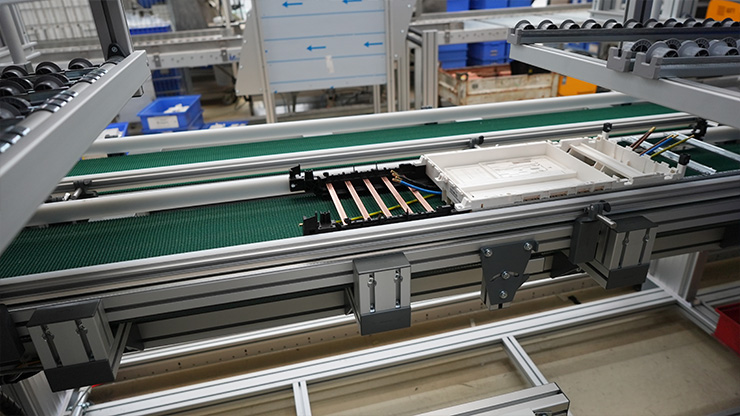
Hager placed great emphasis on ergonomics for the workstations. This can be seen, for example, in the reach width, which should not be greater than 80 cm so that employees can easily reach all important tools and materials. Alexander Markovic comments: "Ergonomics is important for the health of the employees, but also for productivity. Because the further the gripping paths are, the longer my production process also takes. In other words, a clear time factor! Here, we spent a long time tinkering with the MiniTec engineers on how to implement this optimally." The result of the deliberations was finally that the material is arranged within a semicircle. Refilling with the most frequently needed parts is done from the back of the workstations. This means that the assembler is not disturbed in his work and the assembly process can continue without interruption during material replenishment. For the provision of the particularly heavy copper cables, MiniTec roll containers are used, which have already proven themselves many times in the fire department sector.
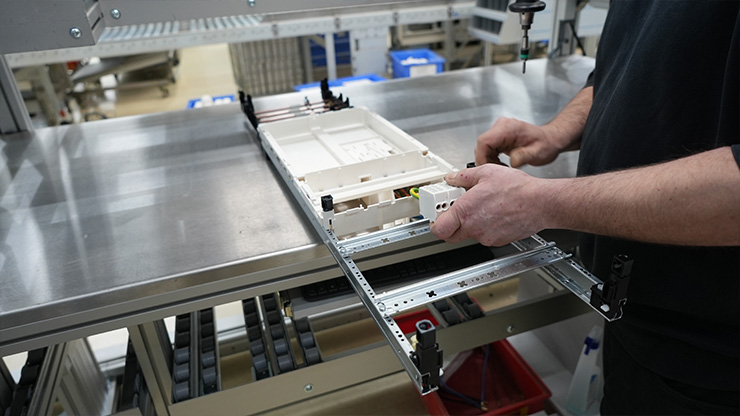
The packing station is docked directly onto the assembly workstations so that the packing process is seamlessly integrated into the material flow. Here, too, replenishment takes place via the back. When cartons need to be replenished, the employee picks them up from the pallet on the back and places them on the work surface of the packing station using the movable table. All assembly stations are electrically height-adjustable in order to optimally adapt them to the height of the employees and to enable fatigue-free work.
The table of the packing station is not only adjustable in height as a whole, but additionally the work surface itself. Thus, the employee can position the complete field on the box without much effort. In addition, the final assembly table and the packing station are connected to each other so that they can be adjusted in height at the same time, with a slight offset. This height offset to the packing station is compensated by the additional height adjustment in the middle of the packing table.
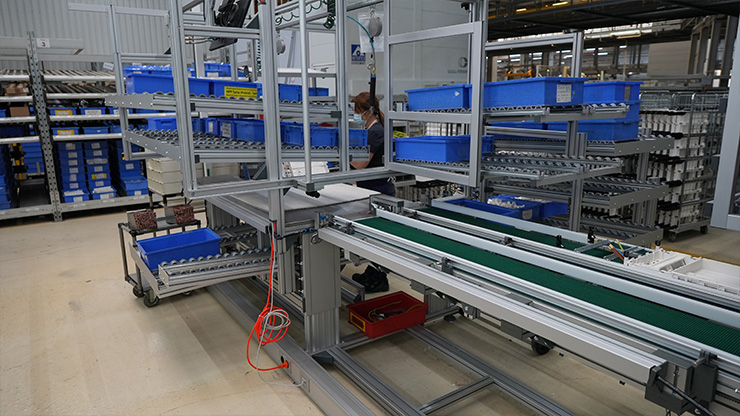
The MiniTec plant is also well thought out down to the last detail. For example, conveyor belts are deliberately used to link the workstations instead of roller conveyors in order to protect the products during onward transport. Just like at a supermarket checkout, the belts are sensor-controlled: If an employee places the product on them, the conveyor belt moves on automatically. The conveyor belt's own drive is also important, of course, in order to compensate for the differences in height mentioned above. If the product has to be transported uphill, this is no problem. The design is such that the conveyor belt automatically adapts to the height adjustment of the work table.
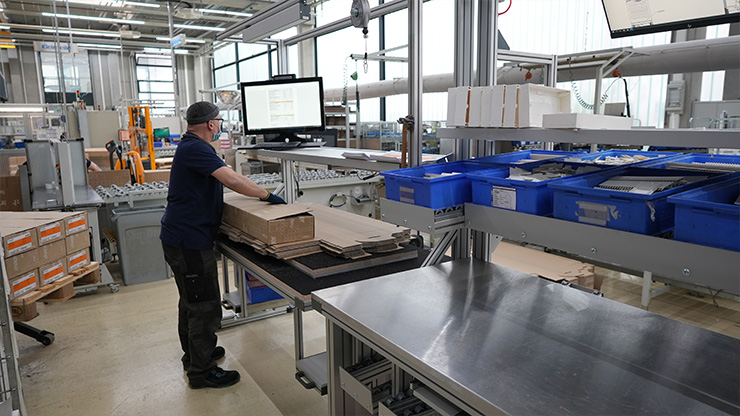
The changeover from a single workstation to a flow production system based on the division of labor was naturally a paradigm shift for the employees, some of whom had been used to the previous way of working for 20 to 30 years. Alexander Markovic is taking a correspondingly cautious approach to the introduction - with many feedback rounds and coordination. During this phase, details are also repeatedly optimized, i.e. the "fine tuning" is carried out. "The introduction is also about finding the right pace. How much does an employee manage so that the material always flows nicely? That's why we also have two conveyor belts between the two stations, which we can use as a buffer. If an employee is sometimes too fast for his follow-up colleague, the conveyor belts act as a buffer - and stoppages are avoided."
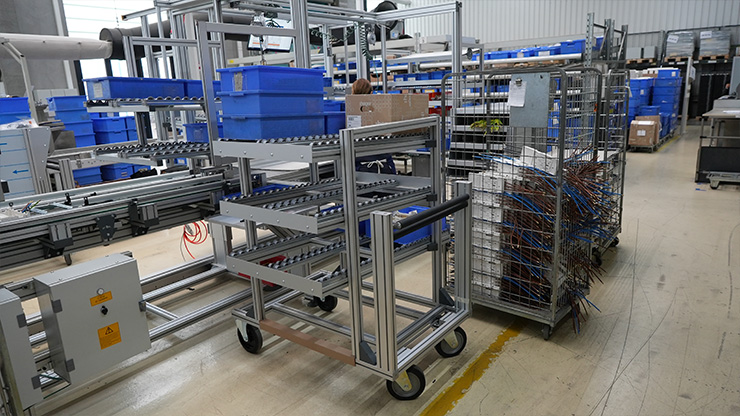
Even though Hager is still in the process of introducing the line, the first effects in the direction of productivity are already being felt. "In the past, we have always gained 20-30 percent in productivity through the changeover to line, and that will also happen here. We are confident that we will significantly improve our productivity within the next six months," says Markovic.
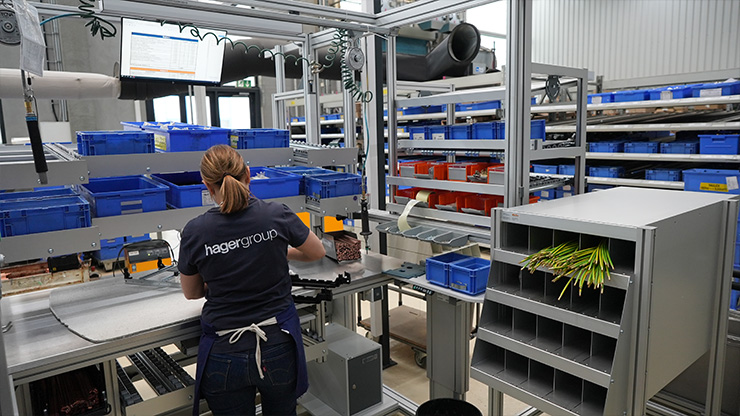
Paperless production is already a reality at Hager. Via monitors at the workstations, employees can display not only the order but also the drawing or the packing instructions for a complete panel. In addition, there is further information such as maintenance and cleaning schedules or the station sheet, which shows what is being produced at which station. Digitalization in the area is to be expanded even further in the future, according to Markovic: "This will be our first production line that we will integrate fully digitally. That means we will connect the line to our ERP (Enterprise Resource Planning - a business management stand software) as well as to our MES (Manufacturing Executive Software - a production control software) in the near future. We will then be able to track production digitally.
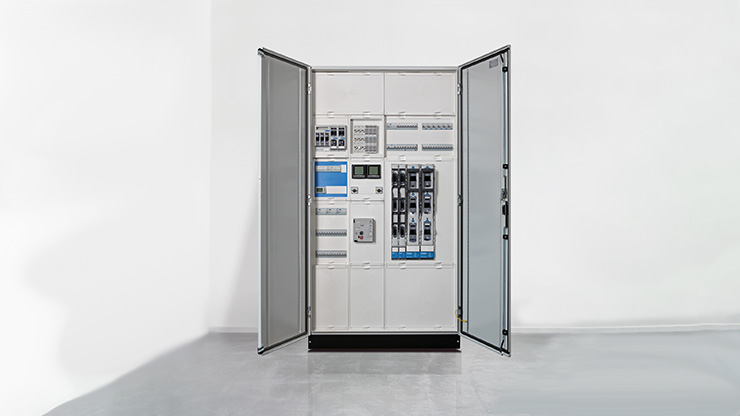
In the future, the orders will be displayed on the monitors of the plant via the ERP system, and the subsequent feedback will also be sent back to the system. Information on the production process, i.e. setups, malfunctions or quality problems, will also be sent as messages via the system so that the shift supervisor can come and provide support."
But the cooperation with MiniTec is also to continue: "When we have finished with the current assembly line for 1-panel complete panels, we definitely want to realize a line for 2-panel products as well, and then possibly even one for 3-panels. The reduction in throughput time and the increase in productivity due to flow production are already enormous, and MiniTec has proven to be an ideal partner for the implementation of corresponding assembly lines."